|

 Up
Up 
 Pilots,
Pilots,
Planes
and Pioneers

(You are here.)
 Down
Down




  Need
to Need
to
find your
bearings?
Try
these
navigation aids:
If
this is your first
visit, please stop by:
Something
to share?
Please:



|
|
Available in Française, Español, Português, Deutsch, Россию,
中文,
日本, and others.
 hile
the Wright brothers may have been the first to make a sustained,
controlled flight, they were just two among hundreds of brave men
and women who helped to give the world its wings during the earliest
days of aviation. Their Flyer was but one of many historically
important aircraft. Below are brief descriptions and photos of some
of the most important people and planes, and where available
resources and links where you can find more information. In some
cases, contributors have supplied expanded
histories and biographies. Those are listed at the right and linked below. hile
the Wright brothers may have been the first to make a sustained,
controlled flight, they were just two among hundreds of brave men
and women who helped to give the world its wings during the earliest
days of aviation. Their Flyer was but one of many historically
important aircraft. Below are brief descriptions and photos of some
of the most important people and planes, and where available
resources and links where you can find more information. In some
cases, contributors have supplied expanded
histories and biographies. Those are listed at the right and linked below.
A
 B
B
 C
C
 D
D
 E
E
 F
F
 G
G
 H
H
 I
I
 J
J
 K
K
 L
L
 M
M
N
 O
O
 P
P
 Q
Q
 R
R
 S
S
 T
T
 U
U
 V
V
 W
W
 X
X
 Y
Y
 Z
Z
|
|
 |
|
Lawrence Hargrave of
Australia began to build models of flying machines in 1885, powered by
tiny motors of Hargrave's own design. In 1889, he built the world's first
radial aircraft engine, although it ran on compressed air and not
gasoline. He invented the box kite in 1893, a remarkably stable kite with
a great deal of lifting power. In 1894, he chained four kites together and
lifted himself 16 feet off the ground in a 21-mph wind. He also built his
first full-size glider in 1894 -- a monoplane based on
Lilienthal's
design, but it was smashed by a gust of wind before he could fly it. In
1895 and 1896, he designed powered flying machines based on box kite form,
but he did not have the same luck building large motors as he did small
ones. He could not fashion a motor that provided the necessary power
within acceptable weight limits, so he had to put his pursuit of power
flight on hold. In 1899, he traveled to England and gave a paper on his
aeronautical work before the Aeronautical Society in London. Hargrave
built his third and last powered machine in 1902, but once again he could
not make an engine to provide sufficient power. He abandoned his research
in 1906.
|
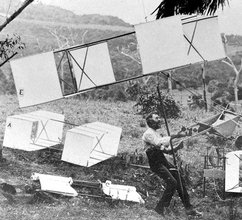
Lawrence Hargraves with a selection of his box kites in 1894.
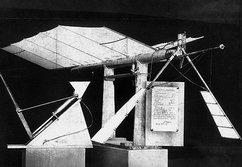
One of Hargraves' flying models. This one was built in 1888 and is
powered by a compressed air engine driving two flappers.
|

Hargraves sketched this man-carrying glider in 1893.
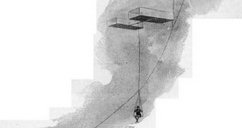
In 1894, Hargraves launched a "train" of box kites that lifted him
into the air.
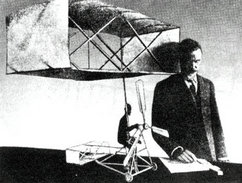
Hargraves with a model of a box-kite airplane in 1902.
|
 |
|
William Samuel Henson
proposed
the Aerial Steam Carriage in 1843, the first airplane design to use propellers
for thrust. It was also the first with an engine in the
fuselage, double-cambered wings, and tricycle landing gear. It was a huge
airplane with 150-foot (46-meter) wingspan and 4,500 square feet (1372
square meters) of wing surface.
Henson, who was in the lace trade in Chard, England, proposed to raise the
money to build it by selling shares in the Aerial Transit Company. He was
was aided in this venture by a superb illustrator and PR agent, Roger
Marriot. Marriot's romantic visions of the Aerial Steam Carriage were
published worldwide and influenced generations of aeronautical scientists
to come. Unfortunately, that's all it did. Henson and his
partner John Stringfellow built a model with a 20-foot (6 meter) wingspan
and made improvements to it between 1844 and 1847. When tested,
it made graceful descending glides but was unable to sustain itself in
the air. Henson quit aeronautics and emigrated to America.
See also:
The First Airplanes. |
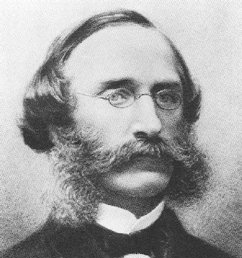
William Samuel Henson.
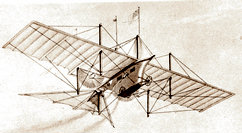
Artists' conception of the Ariel
-- Henson's name for his Aerial Steam Carriage -- first
published in 1843.
|
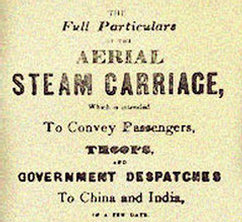
The promotional pamphlet for perspective investors in the Aerial
Transit Company.
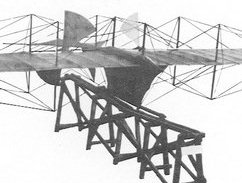
This unsuccessful model of the Aerial Steam Carriage was built and
tested between 1844 and 1847.
|
 |
|
Augustus
M. Herring of Georgia built several unsuccessful gliders in the
early 1890s before turning to Lilienthal-type designs. With these, he was
able to make glides of up to 150 feet (46 meters). This caught the attention of
Octave
Chanute and in 1895 Herring moved to Chicago and built a Lilienthal glider
at Chanute's expense. He left Chanute's employ for a more lucrative job
helping Samuel Langley build his aerodromes at the Smithsonian
Institution. Herring left Langely after less than a year and joined the
band of aviation enthusiasts that Chanute brought together in the sand
dunes outside Miller, IN in June 1896 to test glider designs. During this
expedition, Herring and Chanute collaborated on the design of a
biplane
glider, then refined it over dozens of test flights. By the
time they left Miller in September, the Chanute-Herring glider was the most
capable gliding machine in the world. Later that same year, Herring
came back to the dunes with a triplane version and tested it to see
if it would carry the weight of a motor. He found it would and
prevailed upon Chanute to finance a motorized version. Chanute
turned him down, but they did file a joint patent on the idea.
Mathias Arnot, a banker from Elmira, NY, read about the success of
the Chanute group and employed Herring to create a slightly-improved
Chanute-Herring glider. Herring sub-contracted the construction to
William
Avery, and Avery also helped him test it at Miller, IN. The glider flew well, and Arnot agreed to
finance a motorized version. Herring mounted a
compressed air motor on the aircraft and in 1898 managed several hop-flights
of between 50 and 75 feet (15 to 23 meters). But within a short time, his shop burned and
his patron died. Herring came back to work for Chanute to test an
"oscillating wing"
glider at the Wright camp in Kitty Hawk in 1902. The glider's performance was unspectacular, but Herring
witnessed the Wright's 1902 glider with roll,
pitch, and yaw controls. When he left Kitty Hawk, he headed straight for
Washington, DC and offered to share what he had gleaned from the Wrights
with Langley. To Langley's credit, he refused Herring. In 1903, just 9 days
after the Wrights made their first successful powered flight, Herring
wrote them and offered a three-way partnership as the "true
originator" of the Chanute-Herring glider on which he said their
airplane was based. They ignored his "rascality." In 1908,
Herring bid against the Wrights for the Army contract to build an airplane
and the Army reluctantly gave him a contract, too, as his price was $5000
under the Wrights. Herring arrived at Fort Meyer, Virginia later that year with
two suitcases and an "innovation trunk" that he claimed
"technically fulfilled" his contract. The press had a field day.
When Orville crashed and his contract was extended to give him
time to recover, Herring withdrew, saying he had better offers. He went straight to Glenn Curtiss, who had
begun to manufacture airplanes and was facing a potential patent suit from
the Wright brothers. Herring offered a partnership, saying he had patents
that predated the Wrights. The two formed the Herring-Curtiss Company in
1909 and the Wrights filed a suit, as expected. When Curtiss asked Herring
to produce the patents, Herring excused himself from the meeting and left
town. Later, Curtiss dissolved the company and freed himself of Herring by
declaring bankruptcy. Herring attached himself to another aircraft
manufacturer, Glenn Burgess, and designed a few aircraft. But that
partnership also fizzled. After World War I when Curtiss
was flush with money from Army contracts, Herring reappeared claiming the
Herring-Curtiss Company was never legally dissolved. The suit dragged on
even after Herring died in 1926. His wife eventually received
about a half million dollars. |
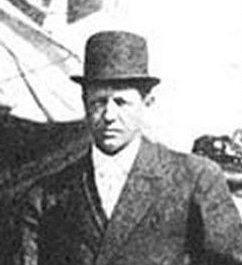
Augustus Moore Herring.
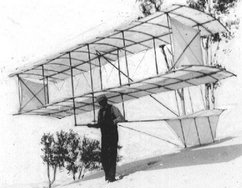
The Chanute-Herring glider at the Indiana Dunes in 1896.
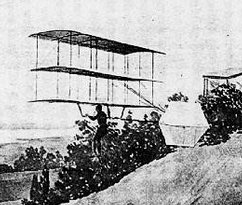
In late 1896, Herring tested a triplane, weighting it with sandbags
to simulate the weight of a motor.
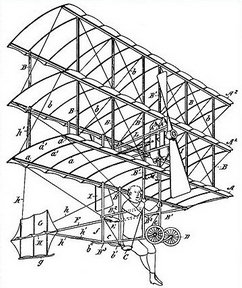
In 1897, Octave Chanute and Augustus Herring jointly patented a
powered triplane, but Chanute would not consent to financing its
construction.
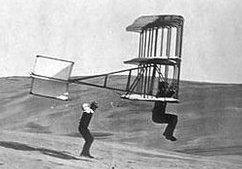
Herring tests the Chanute's "oscilating wing" glider at the Wright
brothers camp in Kitty Hawk, NC in 1902.
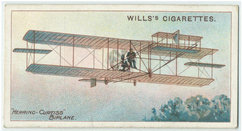
The Golden Flier became the Rheims Flier after Curtiss took it to
Europe and captured the Michelin Cup. Its image was used in
advertisements such as this collector's card.
|
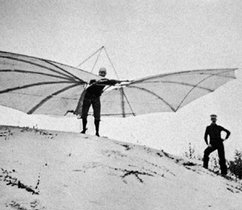
Herring about to launch a Lilienthal-type glider he built for
Octave Chanute in 1894.
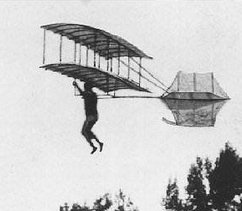
Herring flying the Chanute-Herring glider. In 1896 and 1897, he made
more than 1200 glides.
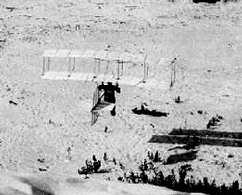
The Herring-Arnot glider of 1897 was very similar to the
Chanute-Herring glider, but Herring made subtle improvements in the
tail and the air frame.
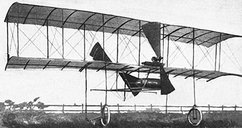
In 1898, with funding from Arnot, Herring built a small biplane
powered in the same manner as his joint patent with Chanute.

The compressed air engine used by Herring in his 1898 airplane. The
motor was not powerful enough to sustain flight, but Herring managed
some brief hops.
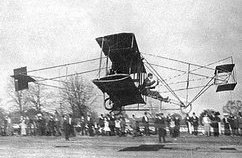
Curtiss-Herring No. 1, better known as the "Golden Flier," was built
in 1909.
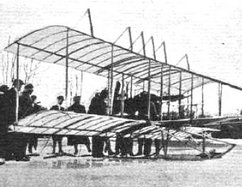
The 1910 Burgess-Herring was nicknamed the "Flying Fish" for the
distinctive fins that sprouted from the top wing. These were
supposed to stabilize the aircraft in flight.
|
 |
Edward Huffaker of
Tennessee was trained as an engineer and surveyor who conducted
experiments with model gliders in the early 1890s. In 1893, he
was the first experimenter to suggest that the lift produced by
curved wings might be the result of the Bernoulli Principle, an
important observation that was ignored for twenty years. He briefly served as
Samuel Langley's
assistant at the Smithsonian Institution and at
Octave Chanute's invitation, presented a scientific paper on his models to
an aeronautical congress. In 1901, Chanute hired him to build a
glider and sent him to Kitty Hawk, North Carolina to test-fly it
along side the Wright brothers. The Chanute-Huffaker glider was a
failure. Additionally, Huffaker's tendency to lecture on
character development, his lack of personal hygiene, and his
inconsideration for their tools and belongings thoroughly annoyed the
Wrights.
|
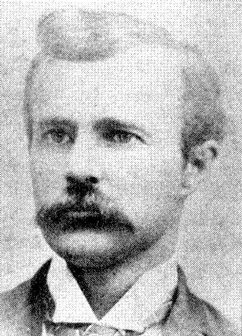
Edward C. Huffaker.
|
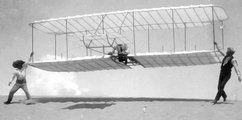
Dan Tate (left) and Edward Huffaker (right) launching Wilbur on the
1901 Wright glider.
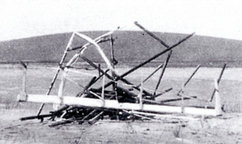
The Chanute-Huffaker glider, because it was built of cardboard
tubes, did not fair well in the weather. It was destroyed during the
first hard rain.
|
 |
|
|
|

